As a makeup professional or a business owner in the beauty industry, you know that understanding the ingredients in makeup products is crucial for your customers’ satisfaction and your business’s success. However, the vast amount of information available on makeup ingredients can be overwhelming, especially if you are just starting.
In this guide, we’ll break down the most common ingredients found in makeup products, explain their functions, and provide you with the tools you need to educate your customers. By the end of this guide, you’ll have a better understanding of makeup ingredients and feel more confident in creating and selling makeup products that are both safe and effective.
So, read on to become a makeup ingredient expert and take your business to the next level!
1. The Basics of Makeup Ingredients
Makeup ingredients are the various components that are used to formulate cosmetic products. These ingredients can be natural, synthetic, or a combination of both, and they are chosen for their ability to improve the appearance, texture, and overall performance of makeup.
Understanding makeup ingredients is crucial for business owners in the cosmetic industry because it ensures that the products they create are safe and effective for consumers. How they make makeup involves understanding the functional and aesthetic properties of each ingredient, allowing business owners to create products that meet specific needs and preferences.

2. Common Makeup Ingredients for Cosmetic Formulation
There are numerous makeup ingredients used for cosmetic formulation, but some of the most common ones include:
Emollients
These ingredients are used to hydrate and soften the skin, and may include oils, silicones, or fatty acids.
Binders
Binders are used to hold the makeup together and create a smooth texture. Common binder ingredients include waxes, polymers, and gums.
Pigments
These provide color to the makeup, and can include natural or synthetic colorants like iron oxides, titanium dioxide, and mica.
Thickeners
Thickeners help increase the viscosity of the product and may include ingredients like cellulose, silica, and clays.
Preservatives
These ingredients help prevent the growth of bacteria and fungi in the product and may include parabens, phenoxyethanol, and benzyl alcohol.
Humectants
Humectants are used to attract moisture to the skin and may include ingredients like glycerin, hyaluronic acid, and urea.
Antioxidants
These ingredients help protect the product from oxidative damage and may include vitamin E, green tea extract, or coenzyme Q10.
It’s important to note that the ingredients used in cosmetics can vary depending on the brand, product type, and formulation. I suggest that consumers take the time to educate themselves on common cosmetic ingredients and their potential benefits and risks.

3. Ingredient Safety and Regulatory Compliance
Here’s a list of some key ingredient safety and regulatory compliance requirements in the cosmetic industry:
FDA Regulations
The US FDA regulates cosmetic products sold in the United States, and requires that they be safe for human use and properly labeled. The FDA also maintains a list of banned and restricted ingredients for use in cosmetics.
EU Regulations
The European Union has strict regulations for cosmetic products sold within the EU. The EU requires that all cosmetic products be safe for human use, properly labeled, and undergo a safety assessment by a qualified assessor prior to market release.
Health Canada Regulations
Health Canada regulates the sale of cosmetic products in Canada and requires that they be safe for human use and properly labeled. Health Canada also maintains a list of banned and restricted ingredients for use in cosmetics.
Cosmetic Ingredient Review (CIR)
The CIR is an independent organization that evaluates the safety of cosmetic ingredients and publishes its findings in the International Cosmetic Ingredient Dictionary and Handbook. I suggest that cosmetic companies consult the CIR’s findings when formulating their products.
International Nomenclature of Cosmetic Ingredients (INCI)
INCI is a standardized system for naming cosmetic ingredients that is recognized worldwide. The use of INCI names helps to ensure that ingredients are properly labeled and understood by consumers.
Good Manufacturing Practices (GMPs)
GMPs are a set of guidelines established by regulatory agencies to ensure that cosmetic products are manufactured, packaged, and labeled in a safe and consistent manner. Compliance with GMPs helps to ensure the quality and safety of cosmetic products.
Safety Testing
Cosmetic companies must conduct appropriate safety testing of their ingredients and finished products to ensure that they are safe for human use. This may include in vitro and in vivo testing, as well as tests for skin and eye irritation, sensitization, and other potential adverse effects.
By complying with these and other ingredient safety and regulatory compliance requirements, cosmetic companies can help ensure that their products are safe, effective, and compliant with relevant regulations and standards.

4. Formulating and Testing Cosmetic Products
Formulating and testing cosmetic products involves several steps to ensure the product is safe, effective, and compliant with regulatory requirements. Here are some of the key steps involved in the process:
Step#1 Formulation
The first step is to create a formula for the cosmetic product. This involves selecting the right ingredients, determining the proper ratios, and considering any specific requirements that the product may have (e.g., stability, pH, viscosity, etc.). This step also involves considering the desired claims of the product (e.g., moisturizing, anti-aging, etc.).
Step#2 Stability Testing
After formulating the product, stability testing is conducted to determine how the product will behave over time. This is important because cosmetic products are often exposed to various conditions, such as temperature changes and exposure to light and air, which can impact their stability and effectiveness. Stability testing helps to ensure that the product remains stable and effective over time.
Step#3 Safety Testing
Cosmetic products must be safe for use by consumers. This involves testing the product for any potential hazards, such as skin irritation or allergic reactions. Safety testing can involve in vitro tests (e.g., cell-based assays) and in vivo tests (e.g., patch tests on human volunteers).
Step#4 Efficacy Testing
After safety and stability testing, efficacy testing is conducted to determine how well the product performs. This involves testing the product on human volunteers to assess its effectiveness in delivering the desired cosmetic benefits.
Step#5 Regulatory Compliance
Cosmetic products must comply with local and international regulations. This includes adhering to labeling requirements, ingredient restrictions, and safety and efficacy standards. Compliance with regulations is essential for ensuring that the product is safe for use and can be marketed and sold legally.
Step#6 Manufacturing and Production
After the product is developed and tested, it is ready for manufacturing and production. The product must be manufactured in a safe and controlled environment to ensure product quality and consistency. I would like to add that during the manufacturing and production process, it’s important to maintain strict quality control to ensure that the final product is consistent.
Overall, formulating and testing cosmetic products is a complex process that requires careful consideration of safety, stability, efficacy, and regulatory compliance. By following these steps, manufacturers can create safe, effective, and desirable cosmetic products that meet the needs of consumers.
5. Choosing Ingredients for Brand Identity
Choosing the right ingredients for a brand’s identity can be a critical part of developing a successful cosmetic product line. Here are some key considerations to keep in mind when selecting ingredients for brand identity:
Brand Values and Positioning
The selection of ingredients should be aligned with the brand’s values and positioning. For instance, a brand that emphasizes natural or organic ingredients should select plant-based or naturally-derived ingredients to reinforce that positioning.
Target Audience
The target audience should be considered when selecting ingredients for brand identity. Different age groups, skin types, and geographic regions may have different needs and preferences. For example, a brand targeting a mature audience may focus on ingredients that address aging skin, while a brand targeting teenagers may focus on ingredients that address acne.
The following table outlines key ingredients and their benefits for different target audiences to help inform ingredient selection.
| Target Audience |
Ingredient |
Benefits |
Details |
| Mature Skin |
Retinol, Vitamin C, Peptides |
Reduces the appearance of fine lines and wrinkles, promotes collagen production, and brightens skin |
- Retinol is a derivative of Vitamin A that helps to reduce the appearance of fine lines and wrinkles.
- Vitamin C is an antioxidant that brightens and evens out skin tone.
- Peptides are amino acids that help to boost collagen production, improving skin firmness and elasticity.
|
| Acne-Prone Skin |
Salicylic Acid, Benzoyl Peroxide, Tea Tree Oil |
Helps to unclog pores, reduce inflammation, and prevent future breakouts |
- Salicylic acid is a beta-hydroxy acid that helps to unclog pores and reduce oil production.
- Benzoyl peroxide is an antibacterial agent that helps to kill acne-causing bacteria.
- Tea tree oil has antibacterial and anti-inflammatory properties that can help to reduce acne.
|
| Dry Skin |
Hyaluronic Acid, Glycerin, Shea Butter |
Moisturizes and hydrates the skin, reduces the appearance of fine lines and wrinkles, and soothes dry and flaky skin |
- Hyaluronic acid is a natural moisturizer that can hold up to 1,000 times its weight in water, helping to hydrate and plump the skin.
- Glycerin is a humectant that helps to draw moisture into the skin.
- Shea butter is a rich emollient that provides long-lasting hydration and helps to soothe dry, irritated skin.
|
| Oily Skin |
Clay, Witch Hazel, Niacinamide |
Absorbs excess oil, minimizes the appearance of pores, and prevents breakouts |
- Clay is a natural ingredient that can help to absorb excess oil and impurities from the skin.
- Witch hazel is an astringent that helps to tighten pores and reduce oil production.
- Niacinamide is a form of Vitamin B3 that can help to regulate oil production and reduce inflammation.
|
| Sensitive Skin |
Aloe Vera, Chamomile, Calendula |
Soothes and calms irritated skin, reduces inflammation, and provides gentle hydration |
- Aloe vera is a natural anti-inflammatory that can help to soothe and calm irritated skin.
- Chamomile has calming and anti-inflammatory properties that can help to reduce redness and irritation.
- Calendula is a natural antioxidant that can help to protect the skin from free radical damage.
|
Ingredient Performance
The ingredients used should be delivered on the promises of the product. This means that they should have demonstrated efficacy in addressing the specific concerns of the target audience, such as moisturization, wrinkle reduction, or skin brightening.
Ethical and Sustainable
Consumers are increasingly interested in the ethical and sustainable practices of the brands they buy from. Choosing ingredients that are responsibly sourced, cruelty-free, and sustainably produced can help communicate a commitment to ethical and sustainable values. I also suggest that companies consider implementing transparent and traceable supply chains to demonstrate their dedication to ethical practices.
In conclusion, choosing the right ingredients is a critical part of building a strong brand identity for a cosmetic product. By considering these factors, brands can create a clear and compelling message that resonates with consumers and sets them apart from their competitors.
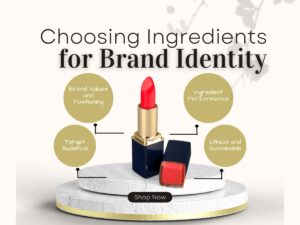
6. Ingredient Trends in the Cosmetic Industry
The cosmetic industry is constantly evolving, and ingredient trends are a big part of that evolution. Here are a few ingredient trends that have gained popularity in the cosmetic industry in recent years:
Natural and Organic Ingredients
Consumers are increasingly drawn to cosmetics that contain natural and organic ingredients. This trend is driven by a desire for products that are free from harmful chemicals and have a more sustainable production process. I recommend this type of ingredient to anyone who is concerned about the health and well-being of their skin and the environment.

Plant-Based Ingredients
Plant-based ingredients have gained popularity due to their perceived environmental and health benefits. Many plant-based ingredients have anti-inflammatory and antioxidant properties that can help soothe and protect the skin.
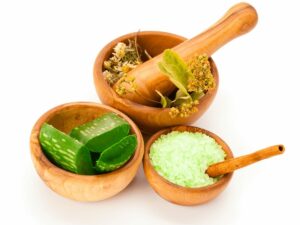
Probiotics
Probiotics are beneficial bacteria that can help balance the skin’s microbiome, which is the ecosystem of microorganisms that live on the skin. They can help improve the overall health and appearance of the skin.

CBD
CBD (cannabidiol) is a non-psychoactive compound found in the cannabis plant that has been used in cosmetics to help soothe and calm the skin. It has gained popularity due to its perceived anti-inflammatory and antioxidant properties.
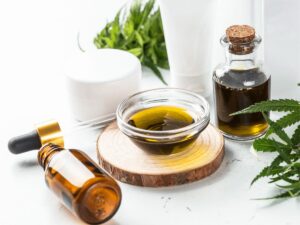
Hyaluronic Acid
Hyaluronic acid is a popular ingredient in skincare products due to its ability to hydrate and plump the skin. It is a naturally occurring substance in the body that can hold up to 1000 times its weight in water.
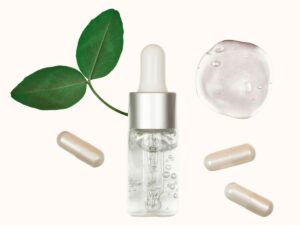
Overall, these ingredient trends reflect a growing demand for products that are natural, sustainable, and beneficial to the skin’s health.
7. 5 Factors To Consider When Choosing Makeup Ingredients
The use of natural and organic ingredients in makeup products is on the rise. According to a report by Grand View Research, the global natural and organic cosmetics market is expected to reach $22 billion by 2025, driven by increased consumer demand for safer and more sustainable products.
To help you choose the right makeup ingredient for your products, here are some factors to consider when selecting makeup ingredients:
#1 Anti-Aging
Look for ingredients like retinol, vitamin C, and hyaluronic acid. These ingredients can help to improve the texture and firmness of the skin, reduce the appearance of fine lines and wrinkles, and boost collagen production.
#2 Hydration
Look for ingredients like glycerin, ceramides, and hyaluronic acid. These ingredients can help to hydrate and nourish the skin, improve the skin’s barrier function, and prevent moisture loss.
#3 Sun Protection
Look for ingredients like zinc oxide and titanium dioxide. These ingredients provide physical sun protection and help to block both UVA and UVB rays.
#4 Skin Type
Consider your skin type when selecting ingredients. For example, if anyone has oily skin, they may want to look for lightweight, oil-free formulas that won’t clog pores. If anyone has dry skin, they may want to look for richer formulas that contain moisturizing ingredients.
#5 Allergies and Sensitivities
If anyone has allergies or sensitivities, be sure to read the ingredient list carefully and avoid any ingredients that may cause a reaction. I also recommend to patch test new products before using them on the face.
By considering these factors when choosing makeup ingredients, you can create a product that is tailored to your specific needs and goals.
If you’re looking for a reliable makeup manufacturer, Nako Cosmetic is a great choice. We offer a wide range of makeup products that are made with high quality ingredients and provide long-lasting, beautiful results. Contact us today to learn more.
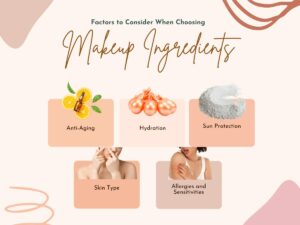
Dive Deeper Into Our Resources
Looking for more diverse product options? Browse through our handpicked selections:
For some insightful reads, we’ve curated a list of recommended articles just for you:
Still haven’t found what you’re looking for? Don’t hesitate to contact us. We’re available around the clock to assist you.
8. Conclusion
In conclusion, understanding makeup ingredients is an essential part of using cosmetics safely and effectively. By taking the time to learn about these ingredients and how they interact with the skin, we can make informed choices about the products we use and reduce the risk of adverse reactions.
I hope this article has helped you gain a better understanding of the importance of understanding makeup ingredients. If you still have any questions or concerns, contact us at Nako Cosmetic. Our team of experts is always here to provide you with more information and guidance on how to choose safe and effective cosmetic products for your business.









